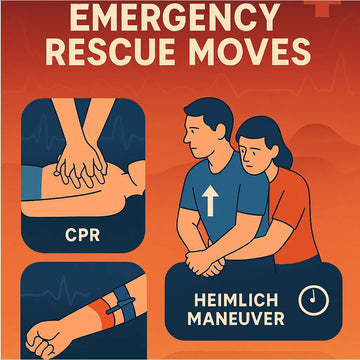When seconds count, knowing the right emergency rescue moves can mean the difference between life and death. Whether it’s a choking incident, cardiac arrest, or severe bleeding, these skills empower you to act decisively. In this guide, we break down 3 essential emergency rescue techniques backed by medical experts, including CPR, the Heimlich Maneuver, and tourniquet application. Let’s dive in.
Why Learn Emergency Rescue Moves?
Every year, over 350,000 cardiac arrests occur outside hospitals in the U.S. alone, and choking remains a leading cause of accidental death. By mastering these life-saving techniques, you become a critical first responder before professional help arrives.
1. CPR (Cardiopulmonary Resuscitation)
When to Use: Unresponsive person not breathing.
Steps to Perform CPR:
-
Call 911 – Alert emergency services immediately.
-
Chest Compressions – Place hands on the center of the chest. Push hard and fast (2 inches deep, 100-120 compressions/minute).
-
Rescue Breaths (if trained) – Tilt the head, lift the chin, and give 2 breaths after every 30 compressions.
Pro Tip: Use the beat of “Stayin’ Alive” by the Bee Gees to maintain the correct rhythm.
Common Mistakes:
-
Incomplete chest recoil.
-
Stopping compressions too soon.
Source: American Heart Association CPR Guidelines
2. The Heimlich Maneuver
When to Use: Conscious choking victim (adults/children over 1 year).
Steps to Perform the Heimlich:
-
Stand behind the person, wrap arms around their waist.
-
Make a fist above the navel, thumb inward.
-
Grasp the fist with your other hand and thrust upward/inward forcefully.
For Infants:
-
Lay the baby face down on your forearm, support the head.
-
Deliver 5 back blows, followed by 5 chest thrusts.
If Alone: Perform abdominal thrusts on yourself using a chair’s edge.
Common Mistakes:
-
Slapping the back (risks pushing the obstruction deeper).
-
Applying pressure to the ribs.
3. Tourniquet Application for Severe Bleeding
When to Use: Life-threatening limb bleeding (e.g., deep cuts, amputations).
Steps to Apply a Tourniquet:
-
Place the tourniquet 2-3 inches above the wound (not on a joint).
-
Tighten until bleeding stops.
-
Note the time applied and inform EMS.
Improvised Tourniquets: Use belts, cloth strips, or tubing if a commercial device isn’t available.
Common Mistakes:
-
Loosening the tourniquet (can restart fatal bleeding).
-
Delaying application in critical cases.
Source: Red Cross Bleeding Control Guidelines
Avoid These Critical Errors in Emergencies
-
CPR: Stopping compressions when the victim gasps (agonal breathing ≠ normal breathing).
-
Heimlich: Performing it on someone who’s coughing (encourage coughing instead).
-
Tourniquet: Waiting too long to use it for uncontrolled bleeding.
Final Thoughts: Practice Saves Lives
While this guide outlines the 3 emergency rescue moves, hands-on training is irreplaceable. Enroll in a certified first aid course (Find a Red Cross Class) to build muscle memory and confidence. Share this article to spread awareness—it might save someone you love.
Need a First Aid Kit?





